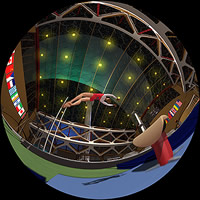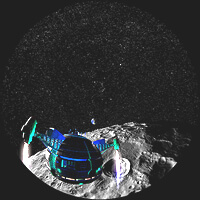"We Choose Space": a unique look at manned space flight
Starting from an historical storyline, fulldome show, We Choose Space, moves quickly on to a look at the NASA manned space program today and then leaps into a peek at the future. This is the first show in a two show pack as part of a three year NASA grant, whose goal is to show where NASA plans on going in the future with manned spaceflight. The "choose" title is a mirror of the John F. Kennedy's speech in 1962 when he said "We choose to go to the Moon".
Beginning with narration by shuttle astronaut Scott Parazynski, the show initially gives a short history of the early days of US manned space flight and continues on into the Apollo era and covers the Lunar landings, all of course utilizing archival footage. Then astronaut Tom Jones narrates a look at today's International Space Station (ISS) starting with dramatic CGI animation showing the assembly of the orbiting laboratory's various nodes.
 At this point a unique fulldome experience unfolds as the story goes inside the ISS, all made possible by the use of fisheye time-lapse images captured during recent missions. A peculiar fisheye was qualified for use in orbit and is used to give the audience real glimpses of life inside the station, then dramatic peeks outside when the camera rig is mounted in the new observation node that has a panorama-like view made possible by the station's largest windows. The Earth can be seen passing below in beautiful fashion just like you were there in orbit with the astronauts on the ISS.
At this point a unique fulldome experience unfolds as the story goes inside the ISS, all made possible by the use of fisheye time-lapse images captured during recent missions. A peculiar fisheye was qualified for use in orbit and is used to give the audience real glimpses of life inside the station, then dramatic peeks outside when the camera rig is mounted in the new observation node that has a panorama-like view made possible by the station's largest windows. The Earth can be seen passing below in beautiful fashion just like you were there in orbit with the astronauts on the ISS.
The final six minutes of the show then moves into the future . An old Walter Cronkite narration is used to take the story into a future scenario where a permanent lunar colony has been established on the Moon. CGI animation then visualizes a scene where an advanced shuttle drops from orbit as it heads for the colony at the NASA preferred location for such a base, the Moon's south pole.
 Hi-rez images of the Moon from the Apollo flights are used as background imagery here. Then LOLA data from the new NASA orbiter altimeter camera is used to create accurate terrain as we fly closer to the lunar surface. On the way we pass radio telescopes taking advantage of the Moon's far side quietness, lunar manufacturing facilities, and tall solar panel towers used to generate power for the colony's dome-shaped biosphere. The domed colony sits dramatically on the rim of an accurately rendered Shackelton Crater and, of course, the scene transitions inside.
Hi-rez images of the Moon from the Apollo flights are used as background imagery here. Then LOLA data from the new NASA orbiter altimeter camera is used to create accurate terrain as we fly closer to the lunar surface. On the way we pass radio telescopes taking advantage of the Moon's far side quietness, lunar manufacturing facilities, and tall solar panel towers used to generate power for the colony's dome-shaped biosphere. The domed colony sits dramatically on the rim of an accurately rendered Shackelton Crater and, of course, the scene transitions inside.
 The interior features living and working quarters, farming areas, a small forest and a central tower that colonists can leap off and fly under their own power in the low-G environment. The Cronkite narrative also speaks of future Lunar Olympic games with 120 foot pole vaults and gymnasts that can soar dramatically through the air in the 1/6 G. These are visualized as the show wraps up this unique look at the future.
The interior features living and working quarters, farming areas, a small forest and a central tower that colonists can leap off and fly under their own power in the low-G environment. The Cronkite narrative also speaks of future Lunar Olympic games with 120 foot pole vaults and gymnasts that can soar dramatically through the air in the 1/6 G. These are visualized as the show wraps up this unique look at the future.
The show is planned to premier the end of November, 2011. Script was written by Carolyn Sumners, audio by Shai Fishman and animation sequences were created by Adam Barnes and Tony Butterfield of the Houston Museum of Natural Science, Marco Zambetti of Tietronix and Tom Casey, Gerry Crouse, Phillipe Velasquez and Warren Casey of Home Run Pictures. Jon Elvert of the Louisiana Art and Science Museum, Pat Reiff of Rice University, and Frank Hughes of Tietronix provided story expertise.
Have you liked this post? Subscribe to FDDB Newsletter
Sign up now, it's free!


















